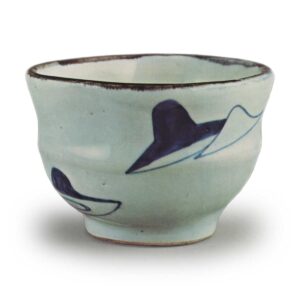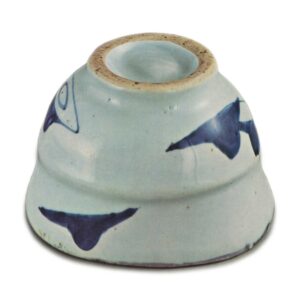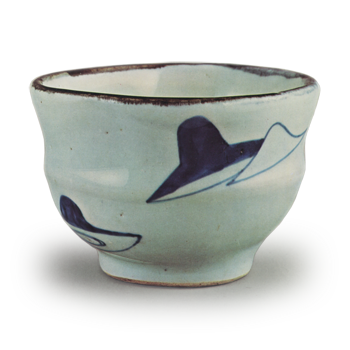

Height: 8.7 to 8.8 cm
Diameter: 11.7 to 13.0 cm
Foot diameter: 6.7 cm
Height: 1.2 cm
The type of pottery known in Japan as Kosometsuke is thought to have been produced in Jingdezhen, Jiangxi Province, during the Tianqi era (1621-1627) at the end of the Ming Dynasty. The Tianqi era was a time of chaos at the end of the Ming Dynasty, with bandits roaming the countryside and the Qing Dynasty’s founding emperor threatening the Ming by establishing his capital in Shenyang.
Compared to the wares produced in Jingdezhen during the Wanli period, the wares produced in Jingdezhen during the Tianqi period are more chaotic in style and, to put it simply, many of them are of a crude and haphazard nature. However, depending on how you look at it, the Tianqi-era underglaze blue and overglaze enamels, which are like a flying horse in the sky, have a charm that is not found in wares from other periods, and they delight pottery lovers.
Although the Tenkei period lasted for only seven years, an astonishing amount of old-style dyed ceramics were imported to Japan during this time. Old-style dyed ceramics scattered throughout the Tohoku and Hokuriku regions in the north and Shikoku and Kyushu in the south are in huge numbers, numbering in the tens of thousands or hundreds of thousands.
However, when we look at the world, it is only in Japan that old dyed ceramics have been handed down. There are quite a few relics in China, including those thought to be from the Wanli period before the Tenkei era and the Chongzhen period after it, and there are also a considerable number in the Philippines, Southeast Asia, as far away as Egypt and Turkey, but the old dyed ceramics from the Tenkei era are only found in Japan, and nowhere else in the world.
The old dyed ceramics include those that were mass-produced as miscellaneous tableware at the time, and tea utensils made to order from Japan. They are listed as tableware for kaiseki cuisine. In terms of quantity, of course, the mass-produced items are more numerous, but what has been prized in our country since ancient times are those that were ordered from Japan and made to order. Flower vases such as Takasago-te, Hishiguchi and Sangi, water jars such as Sakuragawa, Takeno-e, Okegawa, Budobana and Imogashira, incense containers such as Tsujido, Kabutogin, Yoritori, Kikyo, Hikisuteushi and Tateuta , various types of hand-warmer, bowls, and serving dishes were all ordered from Japan and made there, and this tea bowl with a bamboo hat design on the body is an example of this.
Tea bowls with old-style painted bamboo hat designs are rare, and this is the only one I have ever seen.
The body is a pure white porcelain, and on this is a transparent white porcelain glaze, with a blue clay slip, or Chinese-made gosu, scattered in six places to form a pattern of bamboo hats. The composition is also clever, with a thick rim surrounded by gosu, and then a further circle of iron pigment applied to tighten up the rim, which is a nice touch.
The shape is thick, with a tight upper body and a stretched lower body, and a low, large foot ring, which is exactly the kind of shape you would expect to see if it had been ordered and made in Japan. is thick, and the shape is one that seems to have been ordered from Japan and made, with the upper body tightened and the lower body stretched, and a low, large foot ring.
The inside is decorated with a floral pattern on the inside, and the tatami mat is openwork, with the bottom of the bowl being shallowly carved. It is a bowl that looks solid and heavy to the touch, and gives a strong impression.
Kosome



